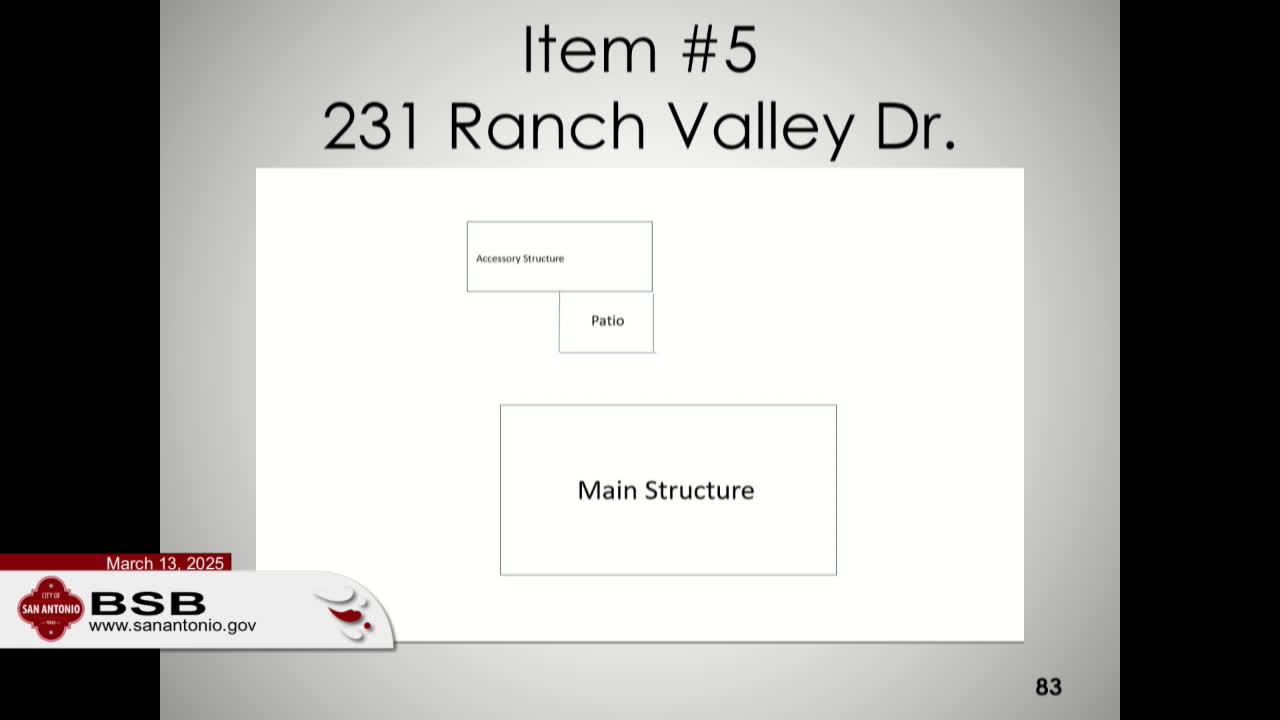San Antonio property owner faces scrutiny for illegal after-hour parties and unauthorized structures
March 13, 2025 | San Antonio, Bexar County, Texas
This article was created by AI summarizing key points discussed. AI makes mistakes, so for full details and context, please refer to the video of the full meeting. Please report any errors so we can fix them. Report an error »

During the recent San Antonio Building Standards Board meeting on March 13, 2025, significant concerns were raised regarding a property located at NCB 15150 Block 048, Lot 23 in City Council District 4. The property, owned by Henry Gomez Jr. and Heather Nicole Gough, has been under scrutiny due to numerous violations related to unauthorized activities and structural modifications.
The meeting featured presentations from various representatives, including the property owner’s attorney, Nathan Gay Case, and a San Antonio Police Officer. Notably, the Office of Historic Preservation confirmed that the property is not eligible for historic designation, which could have implications for its future use and development.
Key issues discussed included the property's use as a venue for after-hours parties, which reportedly involved charging admission and selling alcohol. Inspections revealed that the owner had constructed a new privacy fence without permits, likely to obscure these activities from neighbors. The property is situated within 1,000 feet of Valley High Elementary and Rayburn Middle School, raising additional concerns about safety and community impact.
The inspection conducted on November 15, 2024, highlighted several code violations, including the installation of a DJ setup and a "dancing pool" in the living room, as well as unauthorized modifications to the garage, which had been converted into a bar area. Furthermore, a vending machine offering THC products was found on the premises, alongside a food truck operating without the necessary permits for food sales in a residential area.
The board noted that a notice to vacate had been posted in December 2024, and power to the property was disconnected in January 2025. The ongoing issues at this property reflect broader challenges in maintaining residential standards and ensuring community safety in San Antonio.
As the board deliberates on the next steps, including potential penalties or further actions, the situation underscores the importance of adhering to building codes and regulations, particularly in residential neighborhoods. The outcome of this case may set a precedent for how similar violations are handled in the future, impacting both property owners and the surrounding community.
The meeting featured presentations from various representatives, including the property owner’s attorney, Nathan Gay Case, and a San Antonio Police Officer. Notably, the Office of Historic Preservation confirmed that the property is not eligible for historic designation, which could have implications for its future use and development.
Key issues discussed included the property's use as a venue for after-hours parties, which reportedly involved charging admission and selling alcohol. Inspections revealed that the owner had constructed a new privacy fence without permits, likely to obscure these activities from neighbors. The property is situated within 1,000 feet of Valley High Elementary and Rayburn Middle School, raising additional concerns about safety and community impact.
The inspection conducted on November 15, 2024, highlighted several code violations, including the installation of a DJ setup and a "dancing pool" in the living room, as well as unauthorized modifications to the garage, which had been converted into a bar area. Furthermore, a vending machine offering THC products was found on the premises, alongside a food truck operating without the necessary permits for food sales in a residential area.
The board noted that a notice to vacate had been posted in December 2024, and power to the property was disconnected in January 2025. The ongoing issues at this property reflect broader challenges in maintaining residential standards and ensuring community safety in San Antonio.
As the board deliberates on the next steps, including potential penalties or further actions, the situation underscores the importance of adhering to building codes and regulations, particularly in residential neighborhoods. The outcome of this case may set a precedent for how similar violations are handled in the future, impacting both property owners and the surrounding community.
View full meeting
This article is based on a recent meeting—watch the full video and explore the complete transcript for deeper insights into the discussion.
View full meeting
